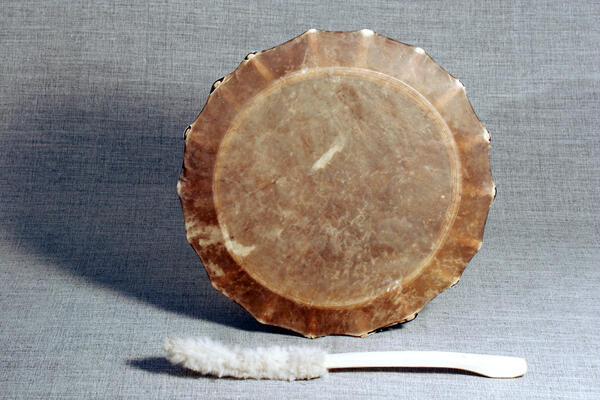Shamanism used to be one of the most popular religious practices among the Forest Nenets, but now it is, indeed, history. The Soviet anti-religious campaign of the 30s of the 20th century is to blame, as it caused extensive damage to the traditional Northern beliefs. Repressions against shamans almost abolished traditional ideology, destroyed a wholesome system of the Nenets’ religious, moral and ethical principles. They are still afraid to openly display their religious beliefs.
In the recent past, the NEnets addressed to a shaman on every important occasion, for example, when a family member got sick, when it was time to set off on hunting or reindeer herd was lost. The Nenets believed that only the chosen ones may become shamans. It was only men, they performed a set of ritual actions called ‘kamlAnie’, interaction with spirits. Shamans employed many ritual items, and a drum was of the greatest importance. It was the drum that helped a shaman enter into a trance state and ask spirits for help, perform rites, foretell the future, travel across different worlds and protect from the evil. A drum was basically the alter ego of its owner, connected to his personal vital energy.
In shamanism, a drum is associated with a reindeer the shaman rides on earth, ascends to Heaven and descends to the Underworld. The round form of this item also has a sacred meaning, it connects the upper world and the world below, becoming the symbol of the Earth. Not only a drum was used to perform a rite, but also other items of plant or animal origin. For instance, among a shaman’s ritual belongings there were pieces of skin of the front paw of an otter, the NEnets sacred animal.
Gubkinsky Museum of the Development of the North exposition displays a drum provided by a Payashata-Kosamy camp resident Yury Pyak. The shell is made of a chopped pine tree trunk and lined with a wild male-reindeer skin. Every drum goes with a rattle, a tool to produce rhythm during a shaman’s ritual singing. A rattle is made of wood and reminds of a narrow and long trowel with fur at one end.
In the recent past, the NEnets addressed to a shaman on every important occasion, for example, when a family member got sick, when it was time to set off on hunting or reindeer herd was lost. The Nenets believed that only the chosen ones may become shamans. It was only men, they performed a set of ritual actions called ‘kamlAnie’, interaction with spirits. Shamans employed many ritual items, and a drum was of the greatest importance. It was the drum that helped a shaman enter into a trance state and ask spirits for help, perform rites, foretell the future, travel across different worlds and protect from the evil. A drum was basically the alter ego of its owner, connected to his personal vital energy.
In shamanism, a drum is associated with a reindeer the shaman rides on earth, ascends to Heaven and descends to the Underworld. The round form of this item also has a sacred meaning, it connects the upper world and the world below, becoming the symbol of the Earth. Not only a drum was used to perform a rite, but also other items of plant or animal origin. For instance, among a shaman’s ritual belongings there were pieces of skin of the front paw of an otter, the NEnets sacred animal.
Gubkinsky Museum of the Development of the North exposition displays a drum provided by a Payashata-Kosamy camp resident Yury Pyak. The shell is made of a chopped pine tree trunk and lined with a wild male-reindeer skin. Every drum goes with a rattle, a tool to produce rhythm during a shaman’s ritual singing. A rattle is made of wood and reminds of a narrow and long trowel with fur at one end.


